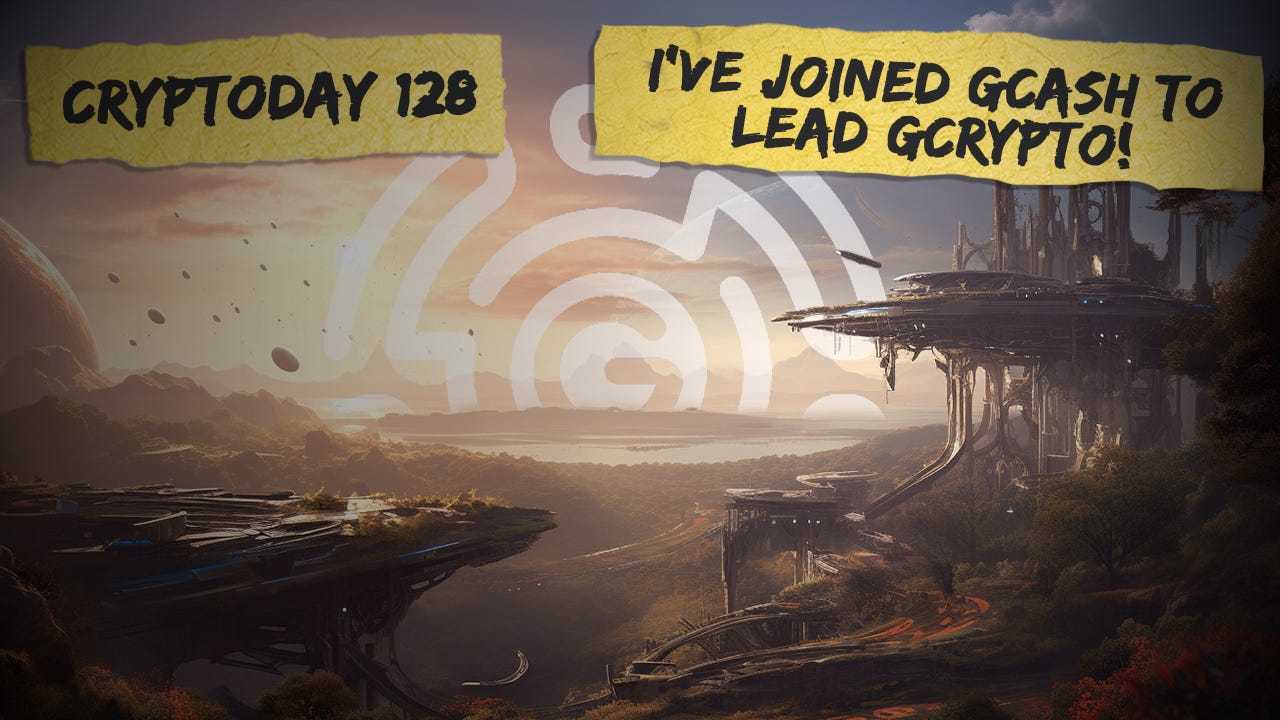I've Joined GCash to Lead GCrypto!
CRYPTODAY 128
This is my first week as GCash’s new head of cryptocurrencies, and my primary focus will be to grow the GCrypto service within the GCash superapp. As I'm just starting, this post isn't going to focus on any forward plans or roadmaps for GCrypto, but is rather a reflection on the growth of crypto in the Philippines, and why I took this job :)
When I first started working in crypto in 2014, the global market cap (i.e., the value of every crypto put together) was a measly $10B. Crypto meetups in the Philippines were lucky to see 30 attendees, and most of those attendees were the employees of the crypto companies sponsoring the event. Ethereum didn't exist yet, and second-order concepts like NFTs, Play-to-Earn, and Web3 were several years away. Projects didn't need to trumpet their "community-building efforts," because the community was all we had. Everyone, from the developers to the media platforms to the end-users, was part of the community, and your membership was assumed as soon as you installed Mycelium. Bitfinex was the most significant exchange in the world, and KYC was a recommendation, not a requirement. We saw early local attempts at all the obvious ideas: a Bitcoin ATM in downtown Makati, a Bitpay-like merchant payments solution, Bitcoin transfers over SMS, a remittance solution settled via Bitcoin. Heck, we even had a social platform where creators could earn crypto by posting their JPEGs.
The largest trading volumes back then were on LocalBitcoins, the now-defunct marketplace that pioneered peer-to-peer crypto trading. Although CoinsPH represented the largest footprint in terms of app-based exchange, I believe they accounted for around 10% of the actual nationwide trading volume, the majority of which was happening in-person and over-the-counter. In 2018, LocalBitcoins’ dominance in the Philippines would be challenged by Paxful, which would itself be eclipsed by Binance’s own P2P marketplace in 2020. Neither LocalBitcoins nor Paxful survived this recent crypto winter, and P2P trading is now relegated to being one of the many sub-offerings of the ruling exchanges, instead of a standalone platform.
2019 saw the rise of NFTs and web3 games. This created a collision between a new community of artists and gamers, and an existing culture that had been driven mostly by speculative investors and a small cult of hardcore believers. Although the newcomers brought some of their own unique sensibilities to the community, eventually the wildly speculative nature of crypto proved to be all-consuming. The feverish hype resulted in NFTs being auctioned for millions of dollars, with bids coming from crypto-wealthy investors with no background in art or art collecting. On the gaming side, standalone Web3 games like Axie Infinity had marketcaps that were almost as large as entire game publishers like Electronic Arts. It was a textbook example of “irrational exuberance,” and for much of the pandemic, this exuberance reverberated throughout social and mainstream media alike.
It was during this same period that GCash experienced a historic growth spurt that would triple its user base, which now stands at over 80M installs. Filipinos became more and more accustomed to digital money, and for a while, it seemed like our society might actually be ready for crypto as well. However, by 2022, the crypto industry was in a state of decline, with high-profile collapses like Luna, 3AC, and FTX, followed by the shuttering of crypto-friendly banks like Silvergate and Silicon Valley Bank. The pendulum was now swinging in the opposite direction, with a thousand death knells sounded across the internet.
The truth, of course, was somewhere in the middle. Crypto wasn't dead, but it wasn’t exactly doing great either. And yes, if you bought any crypto in 2021 you'd be deeply in the red on your investment. I still believe crypto is the best long-term investment you can make, apart from land, but I'm also acutely aware that I've had the luxury of a decade investing in it. Of course, you don't need to start that far back just to make some reasonable returns from crypto. On a full 4-year cycle, a simple, consistent cost-averaging investment strategy will outperform 99% of all amateur traders. Why? Because there are 3x as many bear months as there are bull. Unfortunately, that basic truth has been forgotten in a sea of airdrops, whitelists, and bounties. Instead of diligently saving, newbies burn themselves out gambling with 100x leverage, following alpha-signal pseudo-gurus, and aping into shitcoin projects that are just using them as exit liquidity.
As of 2023, GCash facilitates over 25M transactions daily, powering the businesses of over 5M merchants, and has become a household name. Although the GCrypto app is still in its infancy, I believe it represents the single most important gateway to cryptocurrencies for Filipinos. Not only is GCash installed on the phones of nearly everyone in the country, but over the years it has transformed into a hub for all financial instruments. The question is no longer whether Filipinos are comfortable keeping their money with GCash, but rather how else they can optimize their funds while it's in there.
To someone who has been building towards mainstream crypto adoption since 2014, this represents the opportunity of a lifetime. With calamitous levels of inflation and an economic recession on the horizon, it’s never been more important to save money, and diversifying into various cryptocurrencies is one of the best ways to do that. Fundamentally, I think that it’s an issue of mindset: Filipinos need to start thinking about crypto as a long-term savings alternative, as opposed to a get-rich-quick scheme. I don’t know how long this mental shift will take, or if it’s even possible. But if it does, I’m pretty sure it’ll be GCash that they go to first.
Stay safe out there, cryptofam!



congratulations!!
HUGE get for GCash, congrats Luis